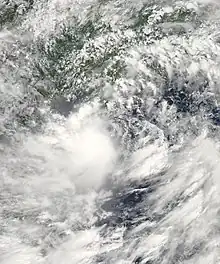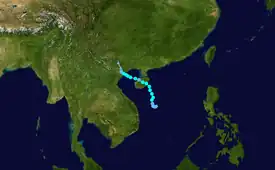 Tropical Storm Kujira at peak intensity on June 22 | |
| Meteorological history | |
|---|---|
| Formed | June 19, 2015 |
| Remnant low | June 24, 2015 |
| Dissipated | June 25, 2015 |
| Tropical storm | |
| 10-minute sustained (JMA) | |
| Highest winds | 85 km/h (50 mph) |
| Lowest pressure | 985 hPa (mbar); 29.09 inHg |
| Tropical storm | |
| 1-minute sustained (SSHWS/JTWC) | |
| Highest winds | 95 km/h (60 mph) |
| Lowest pressure | 985 hPa (mbar); 29.09 inHg |
| Overall effects | |
| Fatalities | 14 total |
| Damage | $31.3 million (2015 USD) |
| Areas affected | Vietnam, China |
| IBTrACS | |
Part of the 2015 Pacific typhoon season | |
Tropical Storm Kujira was a tropical cyclone that prompted the PAGASA to declare the beginning of the rainy season in the Philippines. The ninth tropical depression, 8th named storm, and first storm to make landfall on China in the 2015 Pacific typhoon season,[1] it formed as a tropical depression south of the Paracel Islands on June 19.
Kujira caused 9 deaths in Vietnam due to flash flooding.
Meteorological history

Tropical storm (39–73 mph, 63–118 km/h)
Category 1 (74–95 mph, 119–153 km/h)
Category 2 (96–110 mph, 154–177 km/h)
Category 3 (111–129 mph, 178–208 km/h)
Category 4 (130–156 mph, 209–251 km/h)
Category 5 (≥157 mph, ≥252 km/h)
Unknown
On June 15 at 20:00 UTC, the Joint Typhoon Warning Center (JTWC) began monitoring an area of convection that was located approximately 385 nautical miles (715 km; 445 mi) east-southeast of Huế, with the JTWC assessing the tropical cyclone development potential within the next day as low. The disorganized system was located within favorable conditions for development, with sea surface temperatures in the area ranging from 30–31 °C (86–88 °F).[2] The system began to organize, and on the next day at 06:00 UTC, the JTWC upgraded its development potential within the next day to medium.[3] At 18:00 UTC, the Japan Meteorological Agency (JMA) began issuing warnings on a tropical depression that had formed to the south of the Paracel Islands.[4][5][lower-alpha 1]
On June 20 at 03:00 UTC, the JTWC issued a Tropical Cyclone Formation Alert on the system.[7] Convection continued to deepen over the low-level circulation, and at 15:00 UTC, the JTWC upgraded the system to a tropical depression as it was located approximately 178 nautical miles (330 km; 205 mi) east-southeast of Da Nang, giving it the unofficial designation 08W.[8] On June 21 at 00:00 UTC, the JMA upgraded the depression to a tropical storm, assigning it the name Kujira.[9] The convection became sheared to the southwest of the low-level circulation,[10] and on June 22 at 03:00 UTC, the JTWC upgraded Kujira to a tropical storm.[11] At 12:00 UTC, Kujira peaked in intensity, with maximum sustained winds of 50 mph (85 km/h) and a minimum central pressure of 985 hPa (mbar; 29.09 inHg) as it made landfall on Hainan.[5][lower-alpha 2] The JTWC briefly downgraded Kujira to a tropical depression as it entered the Gulf of Tonkin on June 23 at 03:00 UTC.[12] Kujira briefly re-intensified before making its final landfall on north Vietnam on June 24 at 03:40 UTC;[5][1] the JTWC issued its final warning on Kujira at 03:00 UTC.[13] The JMA issued its final warning on Kujira at 18:00 UTC,[14] dissipating 12 hours later.[5]
Preparations and impact
Vietnam
22 thousand ships were notified of the presence of Kujira on June 21.[15] 31 thousand personnel and over 1 thousand vehicles were mobilized to assist in emergencies.[16] Flash floods killed 14 people, eight of which occurred in Sơn La Province, where rainfall of 280 millimetres (11 in) was recorded.[17] 15 people were injured and 382 houses were submerged, with another seventy being destroyed. 600 hectares of crops were inundated, and 12 bridges and several vehicles were swept away. Landslides throughout the areas affected cut off several sections of highways and roads.[18] In Cua Ong, a peak gust of 26 metres per second (94 km/h; 58 mph) was recorded, and on Bạch Long Vĩ Island, a station recorded a minimum pressure of 984.2 hPa (mbar; 29.06 inHg).[19] 219.9 millimetres (8.66 in) of rain was recorded from June 24–25,[20] with other areas near the coast experiencing heavy rains.[16] Total losses caused by Kujira were about ₫385 billion (US$17.6 million) throughout the country.[21][22][lower-alpha 3][lower-alpha 4]
China
Rainfall from Kujira eased the worst drought in Hainan since 1959.[23] 40 thousand people were evacuated, and 162 flights were cancelled in Haikou Meilan International Airport and in Sanya Phoenix International Airport, which affected 11 thousand passengers.[24] Heavy rainfall and gale-force winds affected Hainan, with high-speed trains between Haikou and Sanya being suspended.[25] 40 thousand people were displaced and 20 thousand fishing boats returned to harbors, and elementary and middle schools in Haikou were suspended.[26] Hainan and Guangxi received between 250–392 millimetres (9.8–15.4 in) of rainfall. In Dongfang, Hainan, rainfall of 312 millimetres (12.3 in) was reported.[27] 159 thousand people were affected, and ¥85 million (US$13.69 million) in economic losses was incurred.[1]
Hong Kong
On June 21 at 13:40 UTC, a Signal No. 1 warning was issued for Hong Kong, before being cancelled on the next day at 23:40 UTC. A gust of 67 kilometres per hour (42 mph) was recorded on Waglan Island. HK$1,570 (US$202) in damages were recorded in Hong Kong.[28]
Elsewhere
Kujira enhanced the southwest monsoon in the Philippines, prompting the PAGASA to declare the beginning of the rainy season.[29] Fishermen were warned of gale conditions in the Andaman Sea and in the Gulf of Thailand. Northeast Thailand experienced precipitation.[30] Rainfall associated with Kujira brought flooding to parts of Myanmar.[31]
See also
- Other tropical cyclones named Kujira
- Tropical Storm Lionrock (2021) – took a similar path in October 2021
Notes
- ↑ The Japan Meteorological Agency is the official Regional Specialized Meteorological Centre for the western Pacific Ocean.[6]
- ↑ All winds are in ten-minute sustained standards, as per the Japan Meteorological Agency,[5] unless otherwise stated.
- ↑ Currencies are converted to US Dollars using XE Currency Converter.
- ↑ All currencies are in their 2015 values unless otherwise noted.
References
- 1 2 3 "Member Report: China" (PDF). typhooncommittee.org. October 26–29, 2015. Retrieved April 24, 2021.
- ↑ "Significant Tropical Weather Advisory for the Western and South Pacific Oceans Reissued from 182000Z-190600Z June 2015". weather.noaa.gov. Joint Typhoon Warning Center. June 18, 2015. Archived from the original on June 30, 2015. Retrieved April 24, 2021.
- ↑ "Significant Tropical Weather Advisory for the Western and South Pacific Oceans from 190600Z-200600Z June 2015". weather.noaa.gov. Joint Typhoon Warning Center. June 19, 2015. Archived from the original on June 30, 2015. Retrieved April 24, 2021.
- ↑ "Warning and Summary 191800". weather.noaa.gov. Japan Meteorological Agency. June 19, 2015. Archived from the original on July 5, 2015. Retrieved April 24, 2021.
- 1 2 3 4 5 Annual Report on the Activities of the RSMC Tokyo – Typhoon Center 2015 (PDF) (Report). Japan Meteorological Agency. 2016. p. 83. Retrieved April 24, 2021.
- ↑ Annual Report on Activities of the RSMC Tokyo – Typhoon Center 2000 (PDF) (Report). Japan Meteorological Agency. February 2001. p. 3. Retrieved April 24, 2021.
- ↑ "WTPN21 PGTW 200300". weather.noaa.gov. Joint Typhoon Warning Center. June 20, 2015. Archived from the original on June 30, 2015. Retrieved April 24, 2021.
- ↑ "Prognostic Reasoning for Tropical Depression 08W (Eight) Warning NR 01". weather.noaa.gov. Joint Typhoon Warning Center. June 20, 2015. Archived from the original on June 26, 2015. Retrieved April 24, 2021.
- ↑ "RSMC Tropical Cyclone Advisory 210000". weather.noaa.gov. Japan Meteorological Agency. June 21, 2015. Archived from the original on June 30, 2015. Retrieved April 24, 2021.
- ↑ "Prognostic Reasoning for Tropical Depression 08W (Kujira) Warning NR 06". weather.noaa.gov. Joint Typhoon Warning Center. June 21, 2015. Archived from the original on June 26, 2015. Retrieved April 24, 2021.
- ↑ "Prognostic Reasoning for Tropical Storm 08W (Kujira) Warning NR 07". weather.noaa.gov. Joint Typhoon Warning Center. June 22, 2015. Archived from the original on June 26, 2015. Retrieved April 24, 2021.
- ↑ "Prognostic Reasoning for Tropical Depression 08W (Kujira) Warning NR 11". weather.noaa.gov. Joint Typhoon Warning Center. June 23, 2015. Archived from the original on June 26, 2015. Retrieved April 24, 2021.
- ↑ "Tropical Depression 08W (Kujira) Warning NR 015". weather.noaa.gov. Joint Typhoon Warning Center. June 24, 2015. Archived from the original on June 26, 2015. Retrieved April 24, 2021.
- ↑ "RSMC Tropical Cyclone Advisory 241800". weather.noaa.gov. Japan Meteorological Agency. June 24, 2015. Archived from the original on June 30, 2015. Retrieved April 24, 2021.
- ↑ "Vietnamese fishermen informed of storm Kujira". VietNamNet. June 22, 2015. Retrieved April 24, 2021.
- 1 2 "Typhoon Kujira set to make landfall today". Việt Nam News. June 24, 2015. Retrieved April 24, 2021.
- ↑ Blašković, Teo (June 26, 2015). "Typhoon "Kujira" brings deadly flash floods to Vietnam". The Watchers. Retrieved April 24, 2021.
- ↑ "Flash floods killed 9, leave 6 others missing in northern Vietnam". Tuoi Tre News. June 26, 2015. Archived from the original on September 25, 2020. Retrieved April 24, 2021.
- ↑ "Member Report: Socialist Republic of Vietnam" (PDF). typhooncommittee.org. October 2015. Retrieved April 24, 2021.
- ↑ Davies, Richard (June 26, 2015). "7 Dead, 4 Missing After Flash Floods in Son La Province, Vietnam". FloodList. Retrieved April 24, 2021.
- ↑ Report on natural disasters and hazards in 2016, VDMA
- ↑ "Ra đường tung lưới bắt cá sau bão số 1 ở Sơn La". VietNamNet (in Vietnamese). June 25, 2015. Retrieved April 24, 2021.
- ↑ Fan, Wang (June 22, 2015). "China issues alert over typhoon Kujira". China News Service. Retrieved April 24, 2021.
- ↑ Blašković, Teo (June 24, 2015). "Typhoon "Kujira" impacts southern China and Vietnam, brings heavy rain". The Watchers. Retrieved April 24, 2021.
- ↑ "Typhoon Kujira makes landfall in south China". China Daily. June 22, 2015. Retrieved April 24, 2021.
- ↑ "China hit by Typhoon Kujira: Facts to know". India Today. June 23, 2015. Retrieved April 24, 2021.
- ↑ Angwin, Richard (June 23, 2015). "Tropical Storm Kujira brings more floods to East Asia". Al Jazeera. Retrieved April 24, 2021.
- ↑ HKO Tropical Cyclones in 2015 (PDF) (Report). Kowloon: Hong Kong Observatory. September 2016. Retrieved April 24, 2021.
- ↑ "PAGASA: Start of rainy season to raise dam water levels, help irrigation". GMA News and Public Affairs. June 23, 2015. Retrieved April 24, 2021.
- ↑ "Tropical storm Kujira to continue to bring rain to Northeast of Thailand". Pattaya Mail. June 27, 2015. Retrieved April 24, 2021.
- ↑ Myint, Moe (June 26, 2015). "At Least One Dead as Southern Burma Lashed by Heavy Rains, Flooding". The Irrawaddy. Retrieved April 24, 2021.
External links
- JMA General Information of Tropical Storm Kujira (1508) from Digital Typhoon
- JMA Best Track Data of Tropical Storm Kujira (1508) (in Japanese)
- 08W.KUJIRA from the U.S. Naval Research Laboratory
